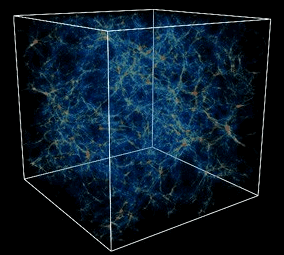More than 90% of the Universe contains material of
unknown composition. We know this Dark Matter
exists, and the only way we can identify it is by
its affect on known objects.
The first clue to the
existence of
Dark Matter is studying the rotation
curve of our
Milky Way galaxy.
Kepler's laws or
rotation (which hold well for planetary orbits
around our Sun) states that stars in the outer
spiral arm should rotate much slower than stars
toward the center of the galaxy; but they don't:

Other evidence that
Dark Matter is a real
phenomenon:
- The halo of a
galaxy contain more mass than
can be seen visually - determined by gravitation
effects on the host galaxy
- Hot X-ray gas found in clusters have
remained due to unseen gravitational forces
- Distortion effects of distant quasars - the
gravity lens
- Light from distant galaxies demonstrate
hydrogen absorption lines from unseen matter
- Motions of
galaxy clusters themselves
indicate some strong gravity influence from
unseen sources
I wrote a project paper on
Dark Matter found in
the
advanced topics section that goes into so detail
about determining possible sources of
Dark Matter.
Basically the two competing theories are:
- Hot Dark Matter
- Cold Dark Matter
Black holes, brown dwarfs,
white dwarfs and other
massive objects only equal a small percentage of
unseen matter. Hot dark matter is thought to be near
zero-mass moving near the speed of light. This can
be relativistic moving massive
neutrinos. Cold dark
matter compose of more massive particles moving
slower than the speed of light.
One interesting effect of
Dark Matter surrounding
a galaxy is that objects that lay behind the galaxy
in the line of sight of an observer will witness
what is called a
gravity lens. The mass of the
galaxy itself is not enough to affect the light from
the distant object, but
Dark Matter can.
(Image credit: Brooks/Cole Thomson Learning)
A dramatic
lens effect is seen with the nearby
cluster of galaxies - Abell 2218:

Computer simulations are very important in
determining the role of
Dark Matter and the
formation of the structure of our Universe. As
discussed earlier, galaxies exist in
clusters and
clusters are members of
superclusters. All of this
is held together by
Dark Matter.
 |
When astronomers use
computers to map
Dark Matter, the result is something like
this image on the left. This particular
frame is a simulation of both Cold and Hot
Dark Matter. The stringy material in the
simulation represents the distribution of
galaxy
superclusters. This is in agreement
with what we observer. |
| For a simulation of Dark Matter, click
the image on the right. This video shows the
gradual formation of structure as time
progresses. This particular video shows a
simulation of Cold Dark Matter (video care
of
Swinburne Astronomy Online). |
 |
The problem that astronomers face now is
attempting to determine if
Dark Matter is Cold, Hot
or both. There are two major theories as to the
structure of our
Universe, and each depends on
either Hot or Cold
Dark Matter.
- The Top Down model - Hot Dark Matter
dominated Universe break apart to form clusters
of galaxies
- The Bottom Up model - A Cold Dark Matter
dominated Universe starts out with small clumps
that coalesce into larger clusters of galaxies
Data is still being collected and debates are
sometimes very heated.
Back to Top |

